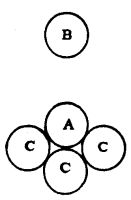The Constant Speed of Light
Table of Contents
Take a number of equally-sized very hard spheres. Arrange them in a straight line so that they touch one another.
Upon striking the first sphere, the motion passes as in an instant to the last of them without us being able to perceive that the others have been stirred.
Even the first sphere that was struck remains motionless with them afterwards.
This shows how movement passes with extreme speed the harder the substance of the spheres.
But this progression of motion is successive and not instantaneous. Therefore, it must take time.
For if the movement, or the disposition to movement, did not pass successively through all these spheres, they would all acquire the movement at the same time. Hence they would all advance together.
But this does not happen.
The last sphere leaves the whole row and acquires the speed of the one which was pushed.
The hardest bodies are quenched steel, glass, and agate. These act as springs and bend somehow when:
- extended as rods
- in the form of spheres or of other shapes.
They yield a little in themselves at the place where they are struck, and immediately regain their former figure.
Strike a large and thick flat glass, slightly soiled with breath, with a ball of glass or of agate. Round marks will remain. These are small or large according as the blow had been weak or strong.
This shows that these substances yield where they meet, and spring back. For this, time must be required.
The particles of the ether are similarly perfectly hard yet are springy as prompt as we choose. This allows the kind of movement of Light.
We do not need to examine here the causes of this hardness or that springiness.
A subtle matter:
- penetrates the ether from every side
- constrains their structure as to give to this fluid matter the most overt and easy passage possible.
The tiny particles of the ether are composed of other parts. Their springiness consists in the very rapid movement of this subtle matter.
This is in line with Descartes’ explanation for the spring. But unlike him, I do not think that its pores are in the form of round hollow canals.
It must not be thought that in this there is anything absurd or impossible, it being on the contrary
It is quite credible that this infinite series of differently-sized corpuscles, with different speeds, are used by Nature to produce so many marvellous effects.
We shall ignore the true cause of springiness. Yet we still see that there are many bodies which possess this property.
Thus, it can also exist in little invisible bodies like the particles of the Ether.
The property of springiness best explains how the movement of Light is successively communicated with uniform progression.
Light would not be able to conserve its great speed over great distances as it goes through more matter if that matter was not springy.
But by supposing springiness in the ethereal matter, its particles will have the property of equally rapid restitution whether they are pushed strongly or feebly.
Thus, the propagation of Light will always go on with an equal velocity.

The particles of the ether are not arranged in straight lines, as in our row of spheres. Instead, they are arranged confusedly.
When one of them touches others, this does not hinder them from transmitting their movement and from spreading it always forward.
There is a law of motion for this propagation, verifiable by experiment.
Assume sphere A touches several other similar spheres C, C, C.
If A is struck by another sphere B in such a way as to exert an impulse against all the spheres C, C, C, it transmits to them the whole of its movement.
Afterdwards, it remains motionless like the sphere B.
I do not think that the ethereal particles are spherical.
Yet this property of communicating an impulse does contributes to the aforesaid propagation of movement.
Equality of size seems to be more necessary.
This is because otherwise there should be some reflexion of movement backwards when it passes from a smaller particle to a larger one, according to the Laws of Percussion which I published some years ago.
However, this equality is more needed for rendering the propagation of light easier and more powerful.
The ether particles could have been made equal so that the light, at least in that vast space beyond our atmosphere. That vast space seems to serve only to transmit the light of the Sun and the Stars.